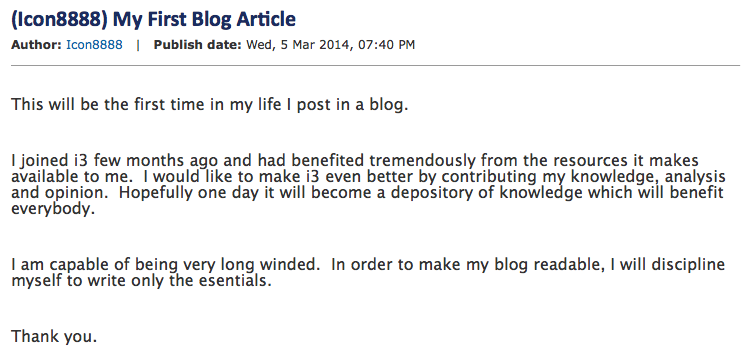Author: Icon8888 | Publish date: Mon, 21 Dec 2015, 07:40 AM
1. The Stone Age

I have been in the market for a long time (just look at my beard). I was quite fortunate. From day one, I have been punting based on prospective PER. I can't remember how I managed to figure that out. But I guess reading analyst reports did lead me to conclusion that share price is mostly driven by earnings, not other things.
During that era, I was the One Eye Man In the Kingdom of The Blind. Most of the people were punting based on NTA. Every time I called up my remisier, without fail, he will tell me that "XXX stock can buy, it is trading at [ ]% discount to NTA". And I will regularly ignore him, and placed orders on stocks that have low PER.
During the Stone Age, information flow was scarce and slow. Only the privilleged had access to stocks related information, mostly through subscription of Bursa announcements, circulars and annual reports, which came in hard copies (!!!).
I still remember going regularly to Bursa, opened up my letter box to extract the documents (yes, they will assign you a letter box if you subscribed).
I was lucky to be staying in KL. Just imagine an Ordinary Joe living in a place like Kampar or Gurun, how on earth was he supposed to have access to those information ?
Due to information asymmetry, the stock market was dominated by Institutional Investors. Retail Investors had minimal influence. They mostly relied on newspapers, which as we all know, was a slow and inefficient medium for information dissemination.
What was the end result ? Based on my observation, the stock market then bore two major characteristics :-
(a) Pricing Inefficiency
Institutional Investors viewed small / medium cap stocks with disdain, citing reasons like illiquidity, unstable earnings, inadequately capitalised balance sheets, etc. As a result, a two tier market developed.
Blue chips and larger cap stocks were actively traded and commanded PER of more than 10 times (which is nice). Announcement of price sensitive information will trigger reactions, just like how an efficient market should behave.
As for small / medium cap stocks, the Stone Age was a frustrating era. A small cap company can generate quarter after quarter of strong earnings and yet share price never move. Many of them traded at low PER of 4 to 6 times.
A selective few that managed to prove themselves by consistently growing for multiple years will finally gain recognition. Even that also came with reluctance. They will usually be slapped with a "Premium" rating of 8 to 9 times PER, as though that was sufficient to pacify them.
Not all are gloom and doomed though, the pricing inefficiency suited small fry like me, which regularly picked up small cap stocks trading at depressed valuation. I called it "Scavenging".
(Icon The Scavenger)
For a Scavenger, the waiting can be frustrating, but the low PE multiple limits potential downside. With a favorable risk reward ratio, I managed to make some money every now and then. Not a lot, but sufficient to spend on movies and dinners without worrying about depleting bank accounts.
(b) Long Bear Cycles
Due to the dominant role played by Institutional Investors, their sentiment dictated the sentiment of the market. Retail Investors were a halpless lot. They were bystanders and their fortune depends on the Big Boys (both local and foreign).
When the Big Boys wake up, bulls will return, and everybody will benefit from the expansion in valuation mutiples.
Other than that, most of the time will be hibernation time - market will be quiet, housewives played mahjong (instead of crowding the public galleries) and remisiers scratched their balls (that is why Remisiers got big balls. I am just kidding).
The Long Bear Cycles suited me too. It gave Icon The Scavenger plenty of opportunities to sift through trash bins to uncover gems.
The Stone Age was truly a fruitful period for me. I managed to build up a small capital base, even after the movies and occasional extravagant dinners.
However, the good time ended abruptly at around 2010. My portfolio went sterile, it stopped producing profit.
The symptoms were as follows :-
(a) Cluelessness
Once sleepy and lifeless, many small and mid cap stocks started waking up at around 2010. The re-rating process was mostly rationale and orderly. It did not happen overnight, but the momentum was clear and unmistakable. I have absolutely no idea what was happening.
As I was accustomed to Stone Age discrimination against small and mid caps, I was paralysed by the sudden burst of energy and market efficiency - a stock with RM45 mil market cap trades at 8 times PER, how dare you !!! It must be a value trap !!!!
And also, I was always several steps behind others. Only after the stocks had gone up by a lot then I will get wind of their stories, mostly through reading newspapers. Why is everybody ahead of me ????
(b) Awful Market Timing
One of the main characteristics of Stone Age is long hibernation period. Occasionally the bulls will make waves. However, once certain negative events set in, they will retreat. It usually take a long time before they return. As mentioned above, Icon The Scavenger loved the Stone Age bulls. Their relative passivity gave Icon plenty of opportunities to sift through the trash bins.
However, beginning 2010, the pattern began to change. The market has turned more resilient, much much more resilient. For example, in 2011, debt crisis exploded in Europe. Intense fear gripped the market. Everybody ran for cover, I was one of them. During Stone Age, Icon The Scavenger will be able to benefit from the stampede. He will be able to take the opprtunity to fish for undervalued gems gradually. However, in 2011, the market recovered faster than Icon The Scavenger expected. By the time I regained my composure, many stocks had already gone up.
What had happened ? Why had Icon The Scavenger lost his midas touch ?
On hindsight, the two symptoms discussed above originated from the same illenss - Inability To Access Information On Timely Manner.
Without many people noticing it, the Information Age has quietly arrived. Internet technology allows many retail investors to gain access to information. Not only that, by congregating around virtual platforms like Low Yat Forum and klsei3investor, these previously obtuse retail investors were suddenly tossed to the forefront of capital market activities. Instead of passively following Investment Banks' recommendations, Retail Investors systematically swap information among themselves, exchange opinions and educate each others. The end result was spectacular. Cross fertilization of ideas provided a big boost to competitiveness. Instead of following Big Boys leads, retail investors now set the agenda.
A new era has begun.
2. The Information Age

From 2010 until 2013, Icon The Scavenger was lost in wildnerness. He didn't manage to make a single sen. No more movies and eating outside. He watched DVDs at home and ate Maggie Mee. Occasionally, he treated himself steamed Tilapia at roadside stalls. That was the only luxury he can afford. Tilapia is the cheapest fish in town. That is why Icon The Pookai Scavenger loved it.
(Icon started making money again in 2014. But he has grown fond of Tilapia. Now he still eats it regularly, not out of necessity, but for enjoyment)
Icon's fortune finally turned in 2014. He bumped into the forum klsei3investor. At the beginning, he used the forum primarily to extract historical financial information.
Slowly, he noticed that the forum is also a place for people to chit chat. Most of the discussions were meaningless though. For example :-
"MyEG go go go. Next week touched RM2.50, wahahahaha"; or
"This stock got potential. Insiders said will get contracts soon. Buy buy buy !!!!"; or
"Lai liao lai liao.... Datasonic going to fly soon..."
But there were valuable information also. KCChong's articles were informative and widely read. Uncle Koon started blogging in early 2014, and he immediately caught my attention (sometime for the wrong reasons, haha).
I followed suit and started blogging in March 2014. The following is my first article :-

From that onwards, klsei3investor became my PRIMARY TOOL FOR INFORMATION COLLATION AND PROCESSING.
In my opinion, the arrival of Internet revolutionalises Bursa in the following ways :-
(a) Forging of Consensus
Cyber platforms like klsei3investor turned out to be very effective in educating retail investors. Through discussions and exchange of information and opinions, consensus gradually emerged over the years covering various aspects of equity investing.
Nowadays, many investors reacted to the same set of information with more or less the same view. For example : earnings growth has huge impact on share price performance, high ROE is indication of a company's competitive strength in the industry, free cash flow is important, gearing up to squeeze out more and more profit is unhealthy, companies that consistently distribute dividend deserve premium valuation, and many many more...
The end result of this convergence of views is that retail investors unconsciously ally themselves to form a powerful force. Their collective financial resources allow them to influence market direction in ways not possible before, which leads to the next point, Democratization of the Market.
(b) Democratization of the Market
During Stone Age, Bursa was dominated by Institutional Investors. As mentioned before, this has resulted in Pricing Inefficiency and Long Bear Cycles.
The Internet changed all these. With the rise of Retail Investors, many stocks that were previously cold storaged had been accorded proper valuation. Gap of valuation gradually diminished.
The rise of Retail Investors also shortened Bear Cycles. Unlike Institutional Investors that managed other people's money, Retail Investors take care of their own financial interest.
They are more enterprising :
(i) Higher tolerance for risks. No need to answer to queries from the top; and
(ii) More hungry. Fund Managers have no incentives taking on any more risk once they achieve certain level of performance. Retail Investors will never have "too much" profit. Every single sen made goes directly into their pocket. The more the better.
As a result, down cycles had become shorter. Unlike Institutional Investors' indifference, Retail Investors rush back to the market at first sign of stabilization.
The easy exchange of information also facilitates that process. It allows Retail Investors to more accurately gauge their surrounding environment. Armed with the information, they have more comfort commiting their capital.
Don't believe me ? Just look at this year (2015). Bursa was hit by a series of bad news - depressed oil price, foreigners pulling out, Mr. Kangkung played magic, falling forex reserves, etc... Bursa went into a mini Bear market. However, the correction lasted for a mere 4 months (from April until August). After that, investors flocked back to the market again. Not only that, many stocks reached all time high (mostly export stocks). The resilience and vibrancy is breathtaking. You don't see that in the Stone Age.
3. Concluding Remarks
If you come to a forum like klsei3investor, you will be shocked by the breadth and depth of the expertise of its members. Nowadays, forum members talk about Free Cash Flow, Enterprise Value, Return On Invested Capital, Earnings Yield, and various investment philosophies with ease. The most appropriate description for them is "Crouching Tigers, Hidden Dragons".
What is the implication ?
The implication is that in this Digital age, information has become a commodity widely available to the masses. To thrive in the market, you need to plug into the system. Otherwise, you will face the same problems that Icon The Scavenger faced few years ago - Out of Touch and Left Behind.
No comments:
Post a Comment